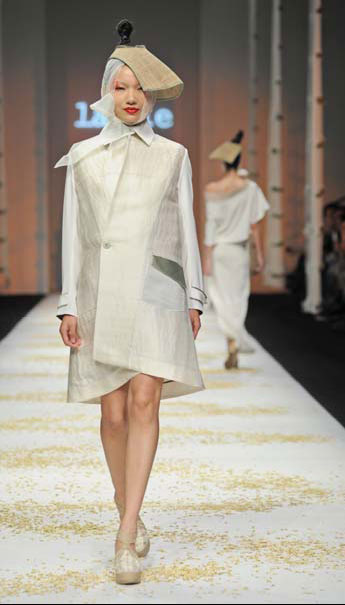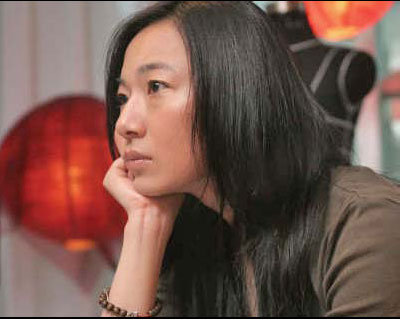Red, white and no blues
Updated: 2013-02-01 09:14
By Yao Jing (China Daily)
|
|||||||||||
|
Above: Ji Cheng chooses to sell in shopping malls to improve the image of her designs. Below: One of her designs from her 2013 spring and summer collection. Photos Provided to China Daily |

Fashion designer has outgrown Shanghai's changle road, ready to reach for the top in haute couture
Fashion designer Ji Cheng has won international acclaim with her Chinese-themed creations and signature red-and-white designs, and she is intent on keeping her success homegrown.
It was only a few months ago that Teasome, her ready-to-wear collection for 2013 spring and summer, was turning heads at London Fashion Week. The show, with designs inspired by 1,200-year-old "Tea Bible" (Lu Yu's Cha Ching), followed one she presented at the city's other biannual fashion week in February.
"London Fashion Week is a springboard for emerging designers, and I think it is time for my brand to appear on a bigger stage as it has been in the market for 10 years," Ji says.
After the shows, Ji signed a contract with the London-based AMF showroom, whose sales agents will help promote her label, and consult on design and material choice to better cater to the international market.
At the same time, she closed her small store in Changle Road, Shanghai, aiming to sell through shopping malls rather than scattered boutiques.
"We have been thinking about how to position the brand, and then decided that the trendy high-street style of Changle Road no longer fitted its image."
She had outgrown the little nest and was spreading her wings - but not too wide and high, fearing an Icarus-like outcome.
While designers around the world battle for the attention of increasing numbers of Chinese consumers, Ji Cheng is wary about rushing into expanding her business outside her homeland. Rather, she hopes to develop an international brand by exposing the rest of the world to the popular aesthetic of contemporary China.
"We are not planning something big, but aiming to keep stable and keep studying."
Ji established her La Vie luxury designer brand when she returned to Shanghai in 2002, after studying at the Instituto Marangoni in Milan and working at Basic Krizia, Missoni Sport and D'A as a designer and visual director.
As with the Teasome collection, her clothes are recognizable for applying symbolic Chinese characteristics using a Western style of cutting in design.
Blue tiger porcelain, 1930s-style Shanghai calendar girls, peacock patterns and other traditional Chinese images have inspired her lines. But she says she is not interested in copying tight-fitting qipao dresses. She wants modernity and variety without stereotyping.
At first her clothes were much more popular among foreigners, who accounted for about 70 percent of her customers.
"Now, only 30 percent of my customers are foreigners as more Chinese, who used to chase overseas brands, accept our style and price today."
A shirt or dress from her ready-to-wear line costs about 4,000 yuan ($642; 476 euros), while a made-to-measure wedding dress or evening dress from her Wedding collection can cost hundreds of thousands.
"We are targeting independent women between 25 and 45 years old who are looking for something special and appreciate freedom in style," Ji says.
Ji operates three retail stores in Shanghai. Among the upmarket outlets of Huaihai Road's shopping strand, one store houses the Wedding line showroom, her studio and workshop.
There, her small office is surrounded by sample designs, while tailors busy behind machines, bench tops and ironing boards create more, most likely for some of the 2,000 VIP clients she says she has garnered.
Downstairs, the showroom is painted red and white, Ji's signature colors. Old wooden furniture and birdcage lights give the setting a traditional feel.
"I like red and white. Once a customer asks for other colors, I feel uncomfortable."
The fashion house's turnover is growing 35 percent each year, Ji says. For La Vie, she introduces about 80 styles of clothes each season, and sells about 45 percent of her total production.
"Although I am looking for more consumers, I do not want my clothes to become common, but to keep the unique style."
Location is becoming more important for a designer, she believes. Footfalls in shopping malls are more steady and consumers tend to be more selective - because each shop is usually clearly positioned and signed - than in the higgledy-piggledy surroundings of fashion streets such as Changle Road.
Ji is approaching shopping malls in China, hoping to open more stores, and her sales agent is promoting her products to department stores in Europe.
yaojing@chinadaily.com.cn
(China Daily 02/01/2013 page16)
Today's Top News
List of approved GM food clarified
ID checks for express deliveries in Guangdong
Govt to expand elderly care
University asks freshmen to sign suicide disclaimer
Tibet gears up for new climbing season
Media asked to promote Sino-Indian ties
Shots fired at Washington Navy Yard
Minimum growth rate set at 7%
Hot Topics
Lunar probe , China growth forecasts, Emission rules get tougher, China seen through 'colored lens', International board,
Editor's Picks

|

|

|

|

|

|






